Attached files
| file | filename |
|---|---|
| 8-K - 8-K - PETROQUEST ENERGY INC | februarypresentationupdate.htm |
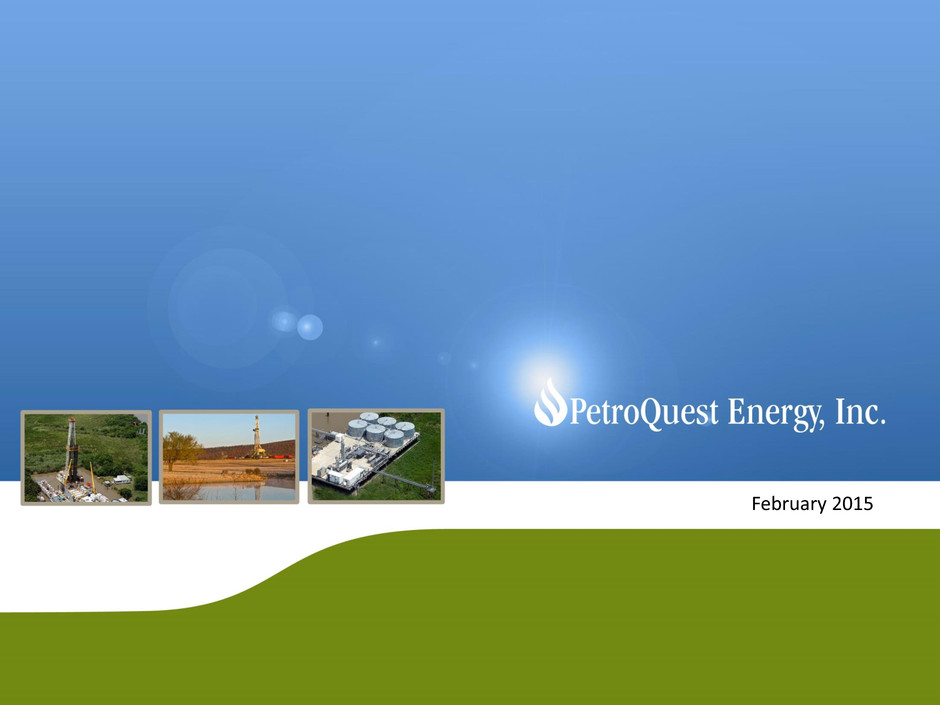
February 2015
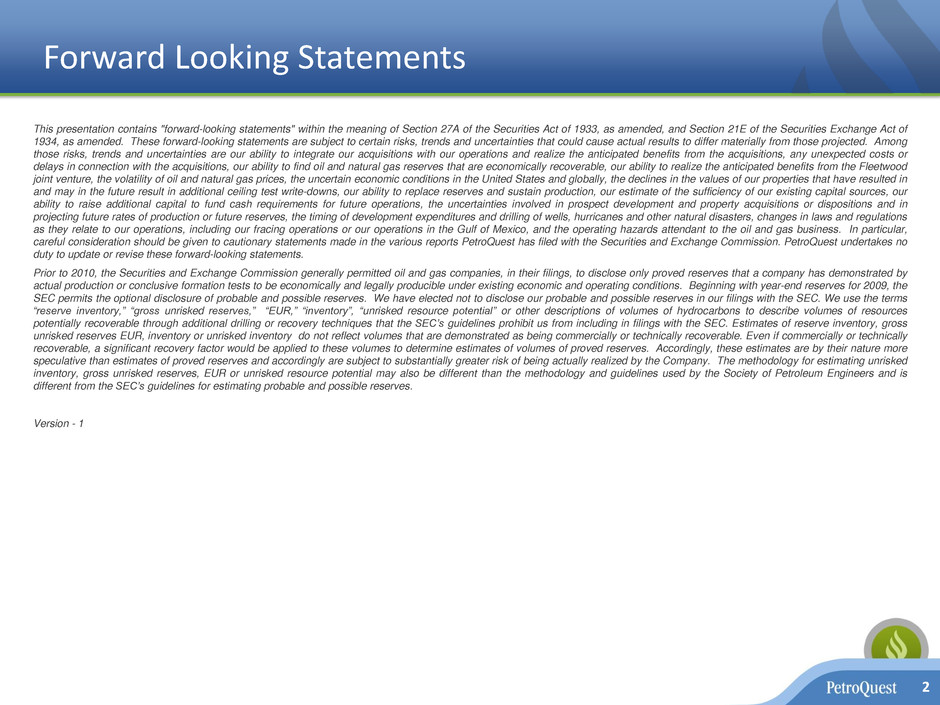
Forward Looking Statements 2 This presentation contains "forward-looking statements" within the meaning of Section 27A of the Securities Act of 1933, as amended, and Section 21E of the Securities Exchange Act of 1934, as amended. These forward-looking statements are subject to certain risks, trends and uncertainties that could cause actual results to differ materially from those projected. Among those risks, trends and uncertainties are our ability to integrate our acquisitions with our operations and realize the anticipated benefits from the acquisitions, any unexpected costs or delays in connection with the acquisitions, our ability to find oil and natural gas reserves that are economically recoverable, our ability to realize the anticipated benefits from the Fleetwood joint venture, the volatility of oil and natural gas prices, the uncertain economic conditions in the United States and globally, the declines in the values of our properties that have resulted in and may in the future result in additional ceiling test write-downs, our ability to replace reserves and sustain production, our estimate of the sufficiency of our existing capital sources, our ability to raise additional capital to fund cash requirements for future operations, the uncertainties involved in prospect development and property acquisitions or dispositions and in projecting future rates of production or future reserves, the timing of development expenditures and drilling of wells, hurricanes and other natural disasters, changes in laws and regulations as they relate to our operations, including our fracing operations or our operations in the Gulf of Mexico, and the operating hazards attendant to the oil and gas business. In particular, careful consideration should be given to cautionary statements made in the various reports PetroQuest has filed with the Securities and Exchange Commission. PetroQuest undertakes no duty to update or revise these forward-looking statements. Prior to 2010, the Securities and Exchange Commission generally permitted oil and gas companies, in their filings, to disclose only proved reserves that a company has demonstrated by actual production or conclusive formation tests to be economically and legally producible under existing economic and operating conditions. Beginning with year-end reserves for 2009, the SEC permits the optional disclosure of probable and possible reserves. We have elected not to disclose our probable and possible reserves in our filings with the SEC. We use the terms “reserve inventory,” “gross unrisked reserves,” “EUR,” “inventory”, “unrisked resource potential” or other descriptions of volumes of hydrocarbons to describe volumes of resources potentially recoverable through additional drilling or recovery techniques that the SEC’s guidelines prohibit us from including in filings with the SEC. Estimates of reserve inventory, gross unrisked reserves EUR, inventory or unrisked inventory do not reflect volumes that are demonstrated as being commercially or technically recoverable. Even if commercially or technically recoverable, a significant recovery factor would be applied to these volumes to determine estimates of volumes of proved reserves. Accordingly, these estimates are by their nature more speculative than estimates of proved reserves and accordingly are subject to substantially greater risk of being actually realized by the Company. The methodology for estimating unrisked inventory, gross unrisked reserves, EUR or unrisked resource potential may also be different than the methodology and guidelines used by the Society of Petroleum Engineers and is different from the SEC’s guidelines for estimating probable and possible reserves. Version - 1

Navigating the Current Environment Flexibility to control capital expenditures Large operated position allows for control of timing of investments - 2015E Capex down 65% from 2014 Majority of acreage is held by production Minimal rig and other contractual commitments Gulf Coast assets generate significant free cash flow ($40MM in 2014) Thunder Bayou estimated to be on-line in 2Q15 at > 38,000 Mcfe/d generating strong cash flow Liquidity position: $145MM of borrowings available and $18MM of cash at 1/1/15 Strong track record of aligning capex to cash flow 3

2014 Recap Proved reserves 31% (Company Record 397 Bcfe) PV-10 26% Production 14% (Company Record 43 Bcfe) Successful drilling programs: De-risked large acreage positions in Woodford and Cotton Valley with excellent drilling results Significant discovery at Thunder Bayou expected to be on-line 2Q15 at > 38,000 Mcfe/d 4
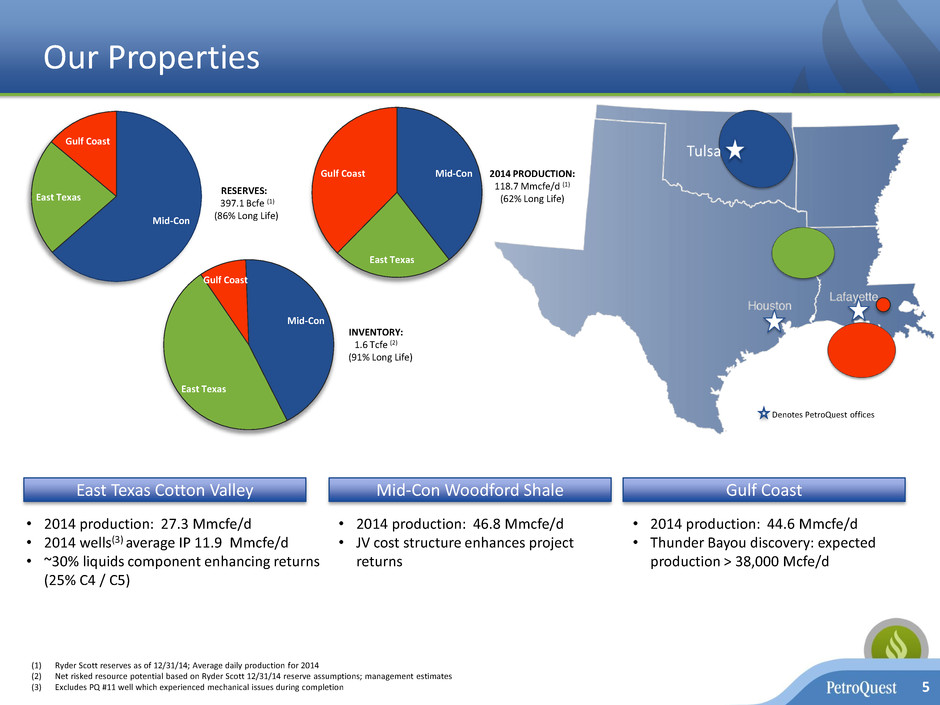
(1) Ryder Scott reserves as of 12/31/14; Average daily production for 2014 (2) Net risked resource potential based on Ryder Scott 12/31/14 reserve assumptions; management estimates (3) Excludes PQ #11 well which experienced mechanical issues during completion Our Properties 5 Mid-Con East Texas Gulf Coast 2014 PRODUCTION: 118.7 Mmcfe/d (1) (62% Long Life) Mid-Con East Texas Gulf Coast RESERVES: 397.1 Bcfe (1) (86% Long Life) Mid-Con East Texas Gulf Coast INVENTORY: 1.6 Tcfe (2) (91% Long Life) Denotes PetroQuest offices Gulf CoastMid-Con Woodford ShaleEast Texas Cotton Valley • 2014 production: 27.3 Mmcfe/d • 2014 wells(3) average IP 11.9 Mmcfe/d • ~30% liquids component enhancing returns (25% C4 / C5) • 2014 production: 46.8 Mmcfe/d • JV cost structure enhances project returns • 2014 production: 44.6 Mmcfe/d • Thunder Bayou discovery: expected production > 38,000 Mcfe/d
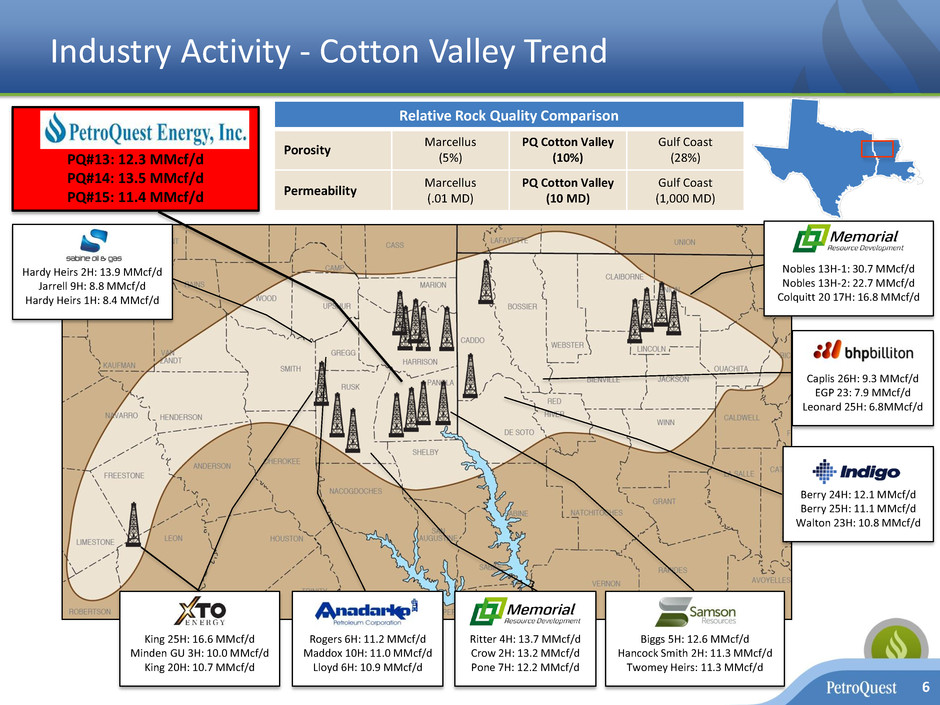
Industry Activity - Cotton Valley Trend 6 Caplis 26H: 9.3 MMcf/d EGP 23: 7.9 MMcf/d Leonard 25H: 6.8MMcf/d Nobles 13H-1: 30.7 MMcf/d Nobles 13H-2: 22.7 MMcf/d Colquitt 20 17H: 16.8 MMcf/d Berry 24H: 12.1 MMcf/d Berry 25H: 11.1 MMcf/d Walton 23H: 10.8 MMcf/d PQ#13: 12.3 MMcf/d PQ#14: 13.5 MMcf/d PQ#15: 11.4 MMcf/d King 25H: 16.6 MMcf/d Minden GU 3H: 10.0 MMcf/d King 20H: 10.7 MMcf/d Biggs 5H: 12.6 MMcf/d Hancock Smith 2H: 11.3 MMcf/d Twomey Heirs: 11.3 MMcf/d Rogers 6H: 11.2 MMcf/d Maddox 10H: 11.0 MMcf/d Lloyd 6H: 10.9 MMcf/d Ritter 4H: 13.7 MMcf/d Crow 2H: 13.2 MMcf/d Pone 7H: 12.2 MMcf/d Hardy Heirs 2H: 13.9 MMcf/d Jarrell 9H: 8.8 MMcf/d Hardy Heirs 1H: 8.4 MMcf/d Relative Rock Quality Comparison Porosity Marcellus (5%) PQ Cotton Valley (10%) Gulf Coast (28%) Permeability Marcellus (.01 MD) PQ Cotton Valley (10 MD) Gulf Coast (1,000 MD)

Cotton Valley Horizontal – Horizontal Uplift 7 Horizontal Completions Realizing 11x EUR Uplift vs. Vertical Wells (1) Ryder Scott estimate excluding PQ #11 well which experienced mechanical issues during completion 0.7 8.6 0 1 2 3 4 5 6 7 8 9 10 61 Vertical Wells 2014 Horizontal Wells (1) A vg . B cfe / W e ll

Cotton Valley Horizontal – Moving Up the Curve 8 Improving Well Performance (1) Excludes PQ #11 well which experienced mechanical issues during completion (1) 6.3 7.4 9.1 11.9 0 2 4 6 8 10 12 2011 2012 2013 2014 A ve rag e IP Ra te ( M m cf e \d ) Liquids Mmcf 2014 Horizontal Cotton Valley Results PQ#10 PQ#11 PQ#12 PQ#13 PQ#14 PQ#15 IP Rate (Mmcfe/d) 10.7 7.9 11.7 12.3 13.5 11.4 30 Day Avg. Rate (Mmcfe/d) 9.9 6.7 10.2 13.8 14.5 13.6 60 Day Avg. Rate (Mmcfe/d) 9.1 5.8 8.8 13.4 13.7 13.5 90 Day Avg. Rate (Mmcfe/d) 9.0 5.2 7.7 13.6 11.7 13.0

Cotton Valley Horizontal Economics 9 Assumptions (1) Gross Well Cost ($MM) 6.2 EUR (Bcfe) 8.6 IP Rate (Mmcfe/d) 11.9 % Gas / Liquids 70% / 30% IRR (%) 38% Payback (Yrs) 2.2(1) 2014 Avg well performance; excluding PQ#11; $3.50 gas / $20.00 NGL Sensitivity to Gas Prices Economic Assumptions IRR 37% Payback: 2.2 IRR 54% Payback: 1.6 IRR 73% Payback: 1.3 IRR 25% Payback 3.0 IRR 38% Payback 2.2 IRR 52% Payback 1.7 20 30 40 50 60 70 80 $3.00 $3.25 $3.50 $3.75 $4.00 IR R - % $6.2MM $5.2MM

Cotton Valley Horizontal Planned Activity and Inventory 10 Near Term Drilling Program Horizontal Cotton Valley Inventory PQ 2011 – 2013 CV Horizontal Wells PQ 2014 (6 Wells) CV Horizontals PQ 2015 (18 Wells) CV Horizontals Existing CV Vertical Wells PQ 2011 – 2013 CV Horizontal Wells PQ 2014 (6 Wells) CV Horizontals PQ 2015/2016 (18 Wells) CV Horizontals PQ 2011 -2013 CV Horizontal Wells PQ 2014 (6 Wells) CV Horizontals PQ 2015/2016 (18 Wells) CV Horizontals PQ CV Horizontal well Inventory

Cotton Valley Drilling to Unlock NAV 11 48.1 89.4 512.7 0 100 200 300 400 500 600 E. Texas Proved 12/31/13 E. Texas Proved 12/31/2014 Net Risked Potential BCF E (6 New Wells) 86% Growth in reserves in 2014

Gulf Coast – Free Cash Flow Generator 12 Houston Lafayette Areas of Interest: Onshore S. LA / Shallow Water GOM Key Operating Metrics Fleetwood Project Area (1) Cash Flow = Revenues less LOE and severance taxes from GCB (2) 2014 Capex excludes non-cash Fleetwood accruals Gulf Coast Assets: Free Cash Flow Funds Growth (1)(2) La Cantera / Thunder Bayou Ten Year Drilling Success Rate: 74% PV-10 ($MM) (12/31/14): $ 209 2014 Production (Mmcfe/d) 45 % Gas: 67% % NGL: 8% % Oil: 25% Over $400MM of Free Cash Flow since 2007 0 20 40 60 80 100 120 140 160 180 2007 2008 2009 2010 2011 2012 2013 2014E $ M M Gulf Coast Cash Flow Gulf Coast Capex $40 MM YTD FCF

La Cantera/Thunder Bayou Shallow Fields 13
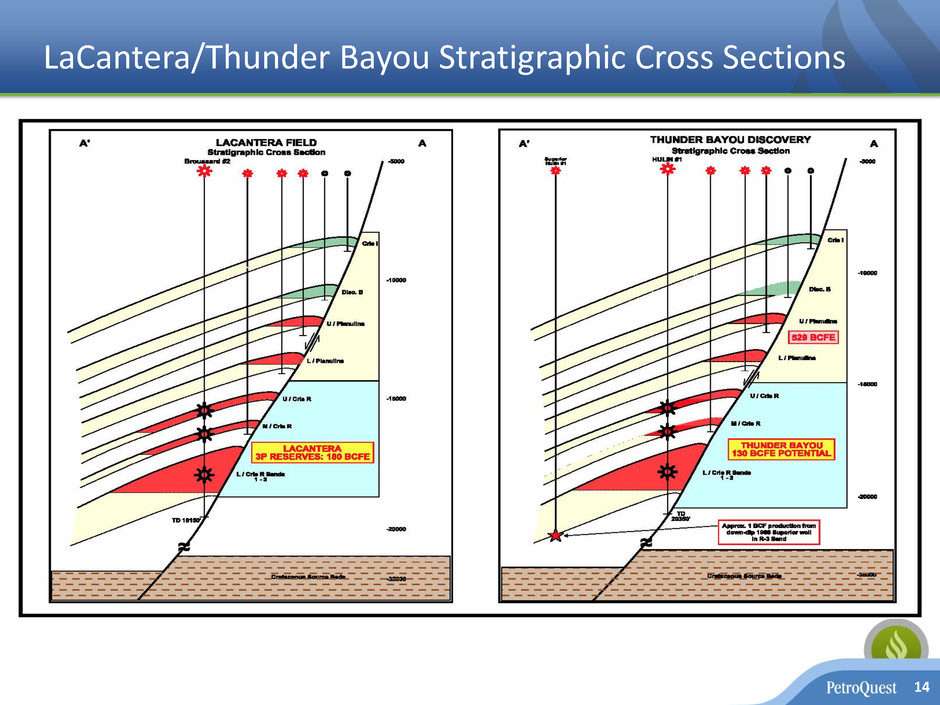
LaCantera/Thunder Bayou Stratigraphic Cross Sections 14
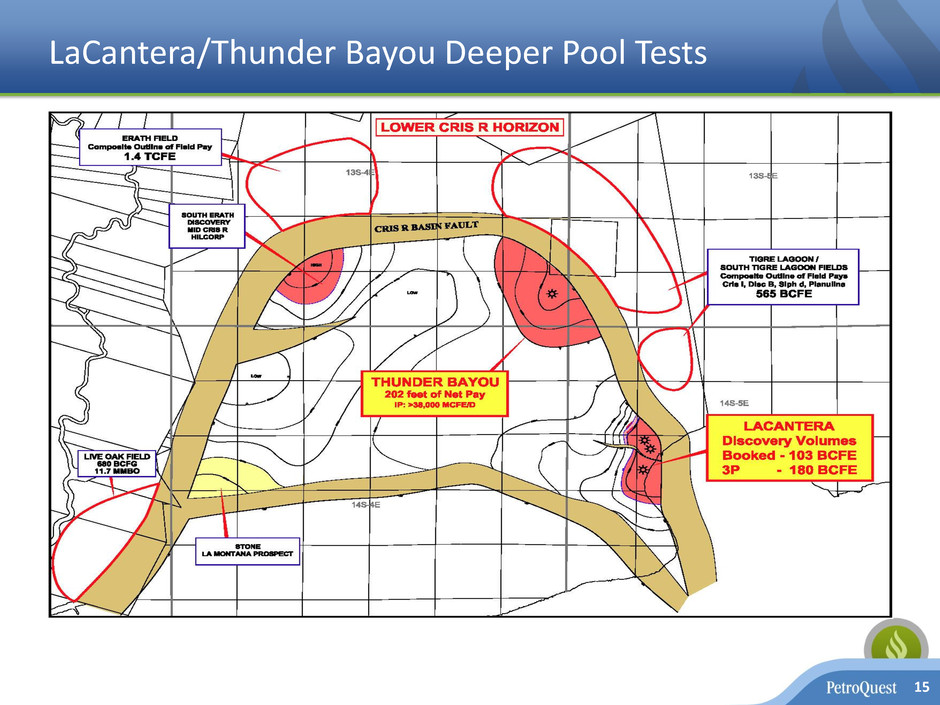
LaCantera/Thunder Bayou Deeper Pool Tests 15

Fleetwood JV Overview • Announced a $24 million joint venture agreement to develop a conventional onshore oil play • $10MM cash; $14MM carry to earn an average 50% w.i. in partners interest in Fleetwood project area • 30,000 gross acre position in West Baton Rouge, Pointe Coupee, Iberville Parishes • Includes exclusive rights to ~200 sq. mile 3D license • PQ operated 16 Fleetwood JV Overview Pintail • Shallow (9,800 feet) normal pressure conventional test • 3 well gross unrisked reserve potential • 21 Bcf and 1,260 MBls • Initial well dry hole cost of $1.6MM (WI-50%) • 1H15 spud Goldeneye • Lower Rowe Sand strat trap • 7 Bcf and 400 MBO gross unrisked reserve potential • 9,800 foot test – dry hole cost of $1.6MM (WI-50%) • 1H15 spud

Mid-Continent Woodford Shale 17 • We currently have a ~34,000 net JV acre position in the West Relay Field which lies approximately 8 miles to the west of our producing North Relay Field • Since our development program began at the beginning of 2014 we have successfully drilled and completed 30 gross wells with significantly higher IP rates and % liquids • PetroQuest benefits from disproportionate cost sharing agreement West Relay Field Overview

Woodford Position – Ramping Up Development 18(1) PQ owns approximately 50% of net JV acres

West Relay Program - Strong Initial Results 19 Higher IP Rates and Liquids Mix 36% 49% 4.6 6.5 0.0 2.0 4.0 6.0 8.0 A ve ra ge I P R ate ( M m cf e \d ) NGLs Gas North Relay (31 well avg.) West Relay (30 well avg.)

Woodford Liquids Rich Gas –West Relay Field 20 Price JV Terms Gas* NGL IRR $ 3.00 $ 16.00 55% $ 3.50 $ 18.00 79% $ 4.00 $ 20.00 97% *Henry Hub JV Terms (1), (2) EUR (Bcfe) 4.6 Gross Well Cost ($MM) 4.0 IP Rate (Mmcfe/d) 7.1 % Gas / Liquids 51% / 49% IRR (%) 79% Sensitivity to Gas Prices 50% 75% 100% 125% $3.00 $3.50 $4.00 IRR: 79% IRR: 97% IRR: 55% Economic Assumptions (1) Assumptions based on 17 gross well average historical results to date and management estimates (2) Return and payback assumptions based on $3.50 gas / $18.00 NGL pricing

Liquidity Metrics and Leverage 21 2013 3Q14 Debt to EBITDA (1)(4) 2.9X 2.7X Interest Coverage (2) (4) 3.5X 4.7X Debt to Proved Mcfe (5) $1.41 $1.07 (1) EBITDA calculated as TTM 9/30/2014 and TTM 12/31/13 (2) Interest calculated as interest expense + capitalized interest annualized (3) Liquidity calculated as sum of cash and availability under borrowing base (4) See reconciliation of EBITDA to net income on appendix 2 (5) Proved reserves and debt as of 12/31/13 and 12/31/14 Liquidity 125 200 220 $50 $150 $250 1Q12 2Q13 3Q14 Borrowing Base ($MM) Does not include ~$50MM of PV10 created by Thunder Bayou Ratios Bank Price Deck $3.79/Mcf $80.86/Bbl

Strong Track Record of Funding Drilling with Cash Flow 22 MM $ Total Direct CapEx and Cash Flows for the period between 2005 and 2014 PQ has balanced Capex and cash flow over the past 10 years (1) (1) Other proceeds include: sale of gathering system, equity proceeds, JV proceeds and other asset sales $1,228 $1,263 $190 $0 $200 $400 $600 $800 $1,000 $1,200 $1,400 $1,600 Direct CapEx (excluding acq.) Cash Flow Other Proceeds

Operating & Financial Metrics $142 $128 $183 $103.9 $177.6 $0 $20 $40 $60 $80 $100 $120 $140 $160 $180 $200 2011 2012 2013 9M13 9M14 21 Revenue ($MM) Discretionary Cash Flow ($MM) (1) $93.4 $77.4 $92.6 $65.2 $100.0 $50 $60 $70 $80 $90 $100 2011 2012 2013 9M13 9M14 Avg. Net Daily Production (Mmcfe/d) PV-10 ($MM) (2) - 20 40 60 80 100 120 140 2011 2012 2013 2014 NGLs Oil Gas 93 104 119 83 $341 $239 $475 $600 $0 $100 $200 $300 $400 $500 $600 $700 2011 2012 2013 2014 (1) Please see reconciliation of discretionary cash flow in appendix 3 (2) Please see the Company’s annual 10-K for a reconciliation of PV-10 to standardized measure
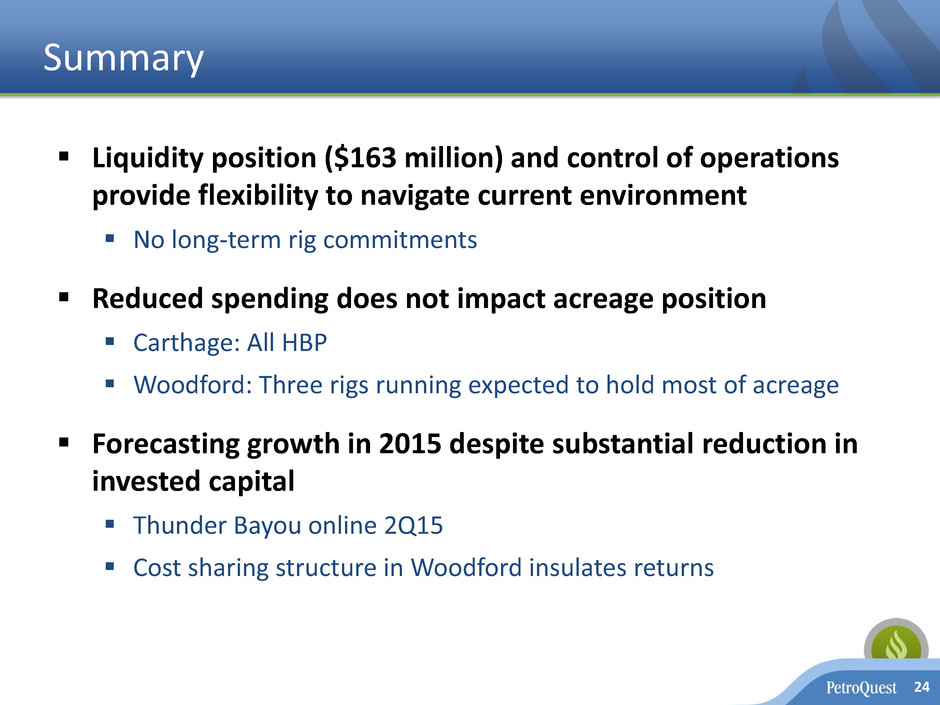
Summary Liquidity position ($163 million) and control of operations provide flexibility to navigate current environment No long-term rig commitments Reduced spending does not impact acreage position Carthage: All HBP Woodford: Three rigs running expected to hold most of acreage Forecasting growth in 2015 despite substantial reduction in invested capital Thunder Bayou online 2Q15 Cost sharing structure in Woodford insulates returns 24
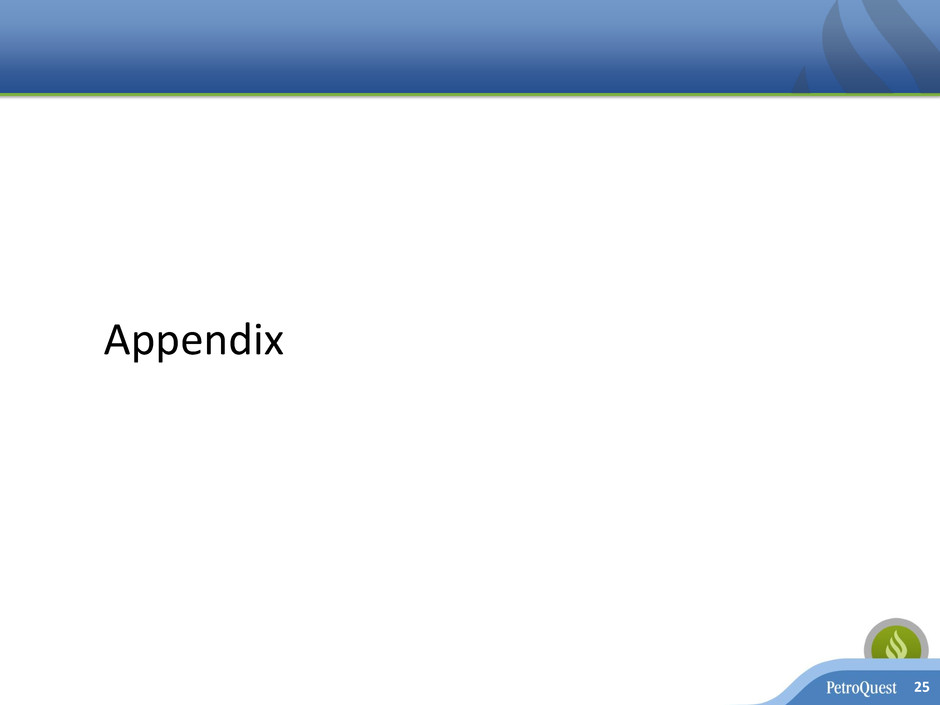
25 Appendix

Appendix 1 - Hedging Positions 26 Natural Gas Daily Hedged Volumes (Mmbtu) Price 2015 10,000 $4.16 2015 5,000 $4.00 2015 5,000 $3.57 2015 10,000 $3.52 Feb15 – Dec15 10,000 $2.93 Mar15 - Dec15 10,000 $3.00 July15 - Jun16 10,000 $3.22 Oil Daily Hedged Volumes (Bbls) Price Feb15 – Dec15 250 $54.00 (1) (1) LLS Index

Appendix – 2 Adjusted EBITDA represents net income (loss) before income tax, interest expense (net), dividends, depreciation, depletion, amortization, non-cash stock compensation expense, gain on sale of gathering assets, accretion of asset retirement, non-cash derivative expense, ceiling test writedowns and loss on early extinguishment of debt and non-cash legal settlement. We have reported Adjusted EBITDA because we believe Adjusted EBITDA is a measure commonly reported and widely used by investors as an indicator of a company’s operating performance. We believe Adjusted EBITDA assists such investors in comparing a company’s performance on a consistent basis without regard to depreciation, depletion and amortization, which can vary significantly depending upon accounting methods or nonoperating factors such as historical cost. Adjusted EBITDA is not a calculation based on generally accepted accounting principles, or GAAP, and should not be considered an alternative to net income in measuring our performance or used as an exclusive measure of cash flow because it does not consider the impact of working capital growth, capital expenditures, debt principal reductions and other sources and uses of cash which are disclosed in our consolidated statements of cash flows. Investors should carefully consider the specific items included in our computation of Adjusted EBITDA. While Adjusted EBITDA has been disclosed herein to permit a more complete comparative analysis of our operating performance relative to other companies, investors should be cautioned that Adjusted EBITDA as reported by us may not be comparable in all instances to Adjusted EBITDA as reported by other companies. Adjusted EBITDA amounts may not be fully available for management’s discretionary use, due to certain requirements to conserve funds for capital expenditures, debt service and other commitments, and therefore management relies primarily on our GAAP results. Adjusted EBITDA is not intended to represent net income as defined by GAAP and such information should not be considered as an alternative to net income, cash flow from operations or any other measure of performance prescribed by GAAP in the United States. The above table reconciles net income (loss) to Adjusted EBITDA for the periods presented. 27 ($ in thousands) 2010 2011 2012 9M13 4Q13 2013 9M14 Net Income (Loss) $41,987 $5,409 ($137,218) $6,652 $2,291 $8,943 $24,306 Income tax expense (benefit) 1,630 (1,810) 1,636 (474) 794 320 (389) Interest expense & dividends 15,091 14,787 14,947 17,905 9,120 27,025 25,920 Depreciation, depletion, and amortization 59,326 58,243 60,689 49,882 21,563 71,445 64,424 Loss on early extinguishment of debt 5,973 - - - - - - Non cash stock compensation 7,137 4,833 6,910 3,105 1,111 4,216 4,025 Non cash gain on legal settlement (4,164) - - - - - - Accretion of asset retirement obligation 1,306 2,049 2,078 1,203 550 1,753 2,223 Derivative (income) expense - - 233 (202) (31) (233) - Ceiling test writedown 18,907 18,907 137,100 - - - - Adjusted EBITDA $128,286 $102,418 $86,375 $78,071 $35,398 $113,469 $120,509

Appendix 3 - Discretionary Cash Flow Reconciliation ($ in thousands) 2011 2012 9M13 4Q13 2013 9M14 Net income (loss) $10,548 ($132,079) $10,506 $3,576 $14,082 $28,160 Reconciling items: Deferred tax expense (benefit) (1,810) 1,636 (474) 794 320 (389) Depreciation, depletion and amortization 58,243 60,689 49,882 21,563 71,445 64,424 Non-cash share based compensation 4,833 6,910 3,105 1,111 4,216 4,025 Ceiling test write down 18,907 137,100 - - - - Accretion of asset retirement obligation 2,049 2,078 1,203 550 1,753 2,223 Other 625 1,114 936 304 1,240 1,636 Discretionary cash flow $93,395 $77,448 $65,158 $27,898 $93,056 $100,079 Changes in working capital accounts 26,686 13,770 (29,834) (168) (29,867) (28,684) Settlement of asset retirement obligations (905) (2,627) (2,415) (920) (3,335) (2,902) Net cash flow provided by operating activities $119,176 $88,591 $32,909 $26,810 $59,854 $125,861 Note: Management believes that discretionary cash flow is relevant and useful information, which is commonly used by analysts, investors and other interested parties in the oil and gas industry as a financial indicator of an oil and gas company’s ability to generate cash used to internally fund exploration and development activities and to service debt. Discretionary cash flow is not a measure of financial performance prepared in accordance with generally accepted accounting principles (“GAAP”) and should not be considered in isolation or as an alternative to net cash flow provided by operating activities. In addition, since discretionary cash flow is not a term defined by GAAP, it might not be comparable to similarly titled measures used by other companies. 28

Appendix 4 - Woodford Dry Gas – Hoss Field Joint Venture 29 Price JV Terms Gas* IRR $ 3.75 55% $ 4.00 65% $ 4.25 70% *Henry Hub JV Terms (1), (2) EUR (Bcf) 4.3 Gross Well Cost ($MM) 5.0 IP Rate (Mmcf/d) 4.0 % Gas 100% IRR (%) 65% Payback (Yrs) 1.4 • 38 dry gas wells included in new joint venture • JV provides extremely beneficial cost sharing provisions for PQ • Drilling in progress Sensitivity to Gas Prices 20% 40% 60% 80% 100% 120% $3.75 $4.00 $4.25 IRR: 70% Payback: IRR: 65% Payback: 1.4 years IRR: 55% Payback: 1.5 years Economic Assumptions Hoss Joint Venture Agreement (1) Assumptions based on average historical results to date and management estimates (2) Return and payback assumptions based on $4.00 gas

Appendix 5 - La Cantera Development 30 15,000 MCF/D + 250 Bbls of oil Lower Cris R-1 Lower Cris R-2, Lobe A Lower Cris R-2, Lobe B Lower Cris R-2, Lobe C (CURRENTLY PRODUCING) (CURRENTLY PRODUCING) ~200 feet of potential pay (CURRENTLY PRODUCING) 18,000 MCF/D + 350 Bbls of oil 4,000 MCF/D + 100 Bbls of oil 34,000 MCF/D + 700 Bbls of oil

Appendix 6 - Panola County Cotton Valley – Room to Run 31 Legend Cotton Valley Wells PQ CV Vertical Wells PQ CV Horizontal Wells PQ Area of Mutual Interest Carthage Field Area – 4.4 TCF of Unrisked Resource Potential 2.2 Tcfe of CV/TP/Bossier Unrisked Resource Potential
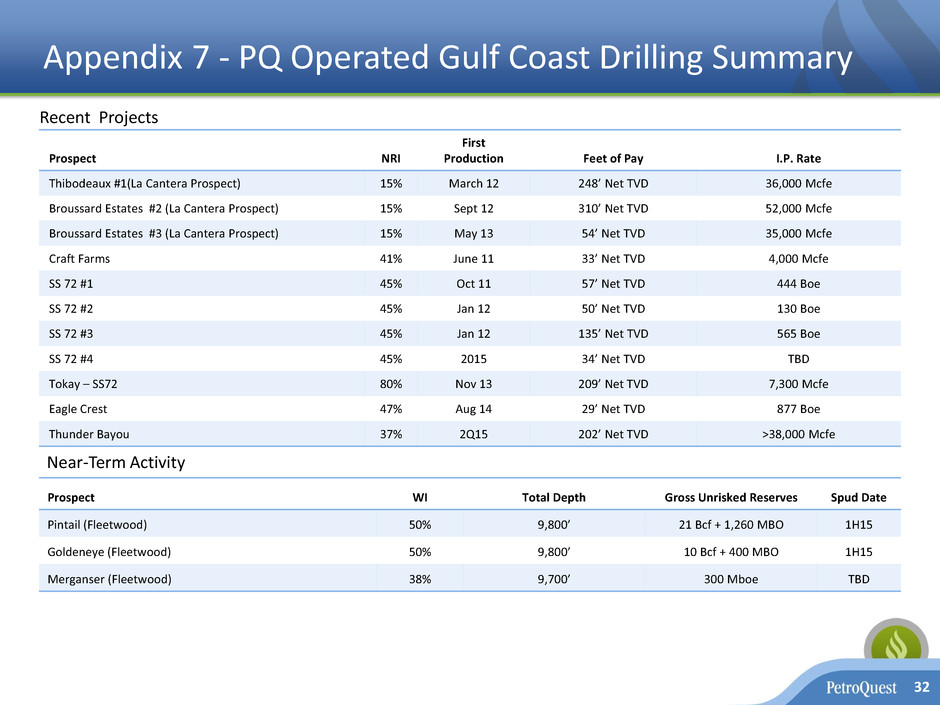
Appendix 7 - PQ Operated Gulf Coast Drilling Summary Prospect WI Total Depth Gross Unrisked Reserves Spud Date Pintail (Fleetwood) 50% 9,800’ 21 Bcf + 1,260 MBO 1H15 Goldeneye (Fleetwood) 50% 9,800’ 10 Bcf + 400 MBO 1H15 Merganser (Fleetwood) 38% 9,700’ 300 Mboe TBD 32 Prospect NRI First Production Feet of Pay I.P. Rate Thibodeaux #1(La Cantera Prospect) 15% March 12 248’ Net TVD 36,000 Mcfe Broussard Estates #2 (La Cantera Prospect) 15% Sept 12 310’ Net TVD 52,000 Mcfe Broussard Estates #3 (La Cantera Prospect) 15% May 13 54’ Net TVD 35,000 Mcfe Craft Farms 41% June 11 33’ Net TVD 4,000 Mcfe SS 72 #1 45% Oct 11 57’ Net TVD 444 Boe SS 72 #2 45% Jan 12 50’ Net TVD 130 Boe SS 72 #3 45% Jan 12 135’ Net TVD 565 Boe SS 72 #4 45% 2015 34’ Net TVD TBD Tokay – SS72 80% Nov 13 209’ Net TVD 7,300 Mcfe Eagle Crest 47% Aug 14 29’ Net TVD 877 Boe Thunder Bayou 37% 2Q15 202’ Net TVD >38,000 Mcfe Near-Term Activity Recent Projects
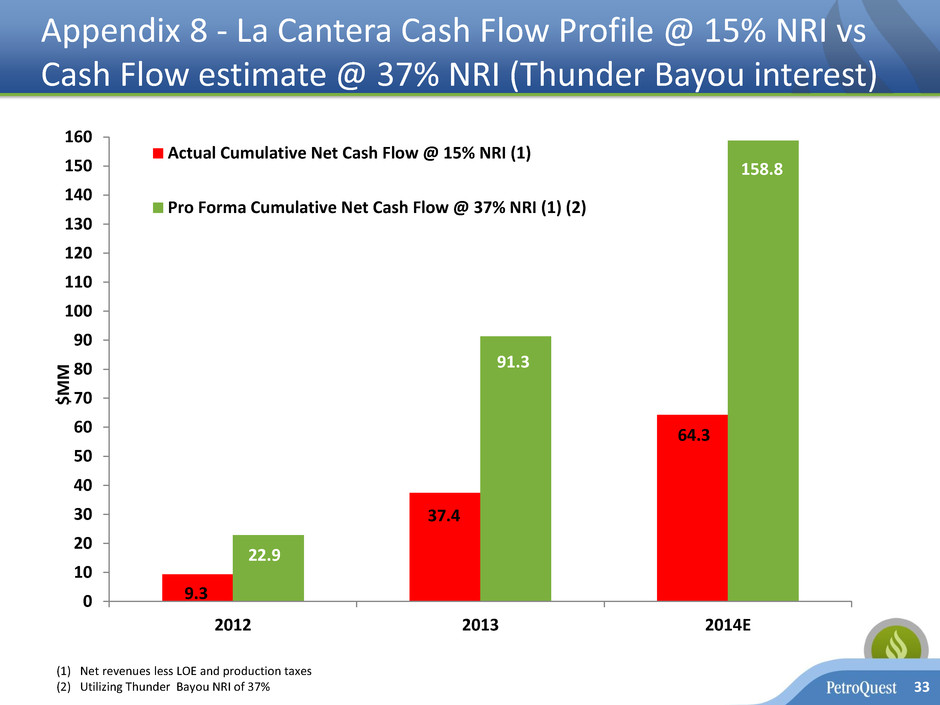
Appendix 8 - La Cantera Cash Flow Profile @ 15% NRI vs Cash Flow estimate @ 37% NRI (Thunder Bayou interest) 33 9.3 37.4 64.3 22.9 91.3 158.8 0 10 20 30 40 50 60 70 80 90 100 110 120 130 140 150 160 2012 2013 2014E $ M M Actual Cumulative Net Cash Flow @ 15% NRI (1) Pro Forma Cumulative Net Cash Flow @ 37% NRI (1) (2) (1) Net revenues less LOE and production taxes (2) Utilizing Thunder Bayou NRI of 37%

Company Information 34 400 East Kaliste Saloom Road, Suite 6000 Lafayette, Louisiana 70508 Phone: (337) 232-7028 Fax: (337) 232-0044 www.petroquest.com This presentation contains "forward-looking statements" within the meaning of Section 27A of the Securities Act of 1933, as amended, and Section 21E of the Securities Exchange Act of 1934, as amended. These forward-looking statements are subject to certain risks, trends and uncertainties that could cause actual results to differ materially from those projected. Among those risks, trends and uncertainties are our ability to integrate our acquisitions with our operations and realize the anticipated benefits from the acquisitions, any unexpected costs or delays in connection with the acquisitions, our ability to find oil and natural gas reserves that are economically recoverable, our ability to realize the anticipated benefits from the Fleetwood joint venture, the volatility of oil and natural gas prices, the uncertain economic conditions in the United States and globally, the declines in the values of our properties that have resulted in and may in the future result in additional ceiling test write-downs, our ability to replace reserves and sustain production, our estimate of the sufficiency of our existing capital sources, our ability to raise additional capital to fund cash requirements for future operations, the uncertainties involved in prospect development and property acquisitions or dispositions and in projecting future rates of production or future reserves, the timing of development expenditures and drilling of wells, hurricanes and other natural disasters, changes in laws and regulations as they relate to our operations, including our fracing operations or our operations in the Gulf of Mexico, and the operating hazards attendant to the oil and gas business. In particular, careful consideration should be given to cautionary statements made in the various reports PetroQuest has filed with the Securities and Exchange Commission. PetroQuest undertakes no duty to update or revise these forward-looking statements. Prior to 2010, the Securities and Exchange Commission generally permitted oil and gas companies, in their filings, to disclose only proved reserves that a company has demonstrated by actual production or conclusive formation tests to be economically and legally producible under existing economic and operating conditions. Beginning with year-end reserves for 2009, the SEC permits the optional disclosure of probable and possible reserves. We have elected not to disclose our probable and possible reserves in our filings with the SEC. We use the terms “reserve inventory,” “gross unrisked reserves,” “EUR,” “inventory”, “unrisked resource potential” or other descriptions of volumes of hydrocarbons to describe volumes of resources potentially recoverable through additional drilling or recovery techniques that the SEC’s guidelines prohibit us from including in filings with the SEC. Estimates of reserve inventory, gross unrisked reserves EUR, inventory or unrisked inventory do not reflect volumes that are demonstrated as being commercially or technically recoverable. Even if commercially or technically recoverable, a significant recovery factor would be applied to these volumes to determine estimates of volumes of proved reserves. Accordingly, these estimates are by their nature more speculative than estimates of proved reserves and accordingly are subject to substantially greater risk of being actually realized by the Company. The methodology for estimating unrisked inventory, gross unrisked reserves, EUR or unrisked resource potential may also be different than the methodology and guidelines used by the Society of Petroleum Engineers and is different from the SEC’s guidelines for estimating probable and possible reserves. Version - 1
